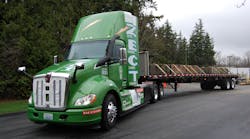I’m told a little apprehension is normal when one slips behind the wheel of a $7 million vehicle officially referred to as a “customer demonstration prototype field test truck” within the engineering team at Kenworth Truck Co.; a vehicle otherwise known as the hybrid-electric T680 Zero Emission Cargo Transport (ZECT) tractor
I got even more nervous when I “stalled” the ZECT out twice during my trip around the test track at the PACCAR Technical Center in Mt. Vernon, WA; a “stall” due to an overspeed miscommunication between the truck’s four-speed automated transmission and its dual-rotor electric motor.
Yet the experience proved instructive as this truck is only just now becoming reality after two years of development work, with more than a few “tweaks” still left to be worked out before real-word testing at the ports of Long Beach and Los Angeles begins in the next few months.
“We are still real early in the development process,” Brian Lindgren, Kenworth’s research and development manager, explained to me during one of several test drives in the T680 ZECT, which really only got “up and running” in his words back in December.
“There is still a lot of tweaking to do; we are still working through the [transmission] shifting algorithms,” he explained.Of course that’s to be expected with a truck that’s very different in design than the nominal diesel-powered tractors now operating on our roads today:
- A comparable diesel-powered T680 daycab tractor weighs in at 16,000 lbs.; the ZECT weighs 22,000 lbs. due to the batteries, heating/cooling system for battery protection, hydrogen storage tanks, etc. “We have added about 6,000 lbs. to this truck compared to a diesel model, but that will be coming down,” said Lindgren. “It could drop by as much as half in the next five years.” It’s also slightly heavier than a comparable natural gas-only powered tractor as well, he said.
- The ZECT is powered by a dual-rotor electric motor that generates 420 kilowatts (kW) of power, which is equivalent to a 560 hp engine. Thus it can pull “nominal” Class 8 freight loads fairly easily; the ZECT test tractor-trailer sported a 78,980 lbs. gross combination vehicle weight (GCVW).
- “We have decided to leave the electric motor within the frame of this truck, with a standard prop shaft connected back to a standard rear axle,” Lindgren said. “Putting the electric motors within the axle or wheels would lose power and torque.”
- The fuel cell cranks out 85 kW and serves to recharge the truck’s 2,000 lb. lithium-ion battery pack, which in turn feeds the electric motor. That 2,000 lbs. worth of batteries also requires 1,500 lbs. of “support equipment,” he noted, from brackets to cooling/heating systems required to ward off the impact of extreme external temperatures. “Like us humans, fuel cells like ‘room temperature’ he best – not too, hot not too cold.”
- “I think once we get the fuel cell up to 200 kW or 250 kW output [power] range we will see some changes; the ability to pull hill grades that are steeper and longer, for example,” Lindgren told me. “Right now 85 kW does not match the 400 kW output of the motor; so the fuel cell consumes more hydrogen to keep up with [motor] power demand. Once you attain that greater output then you can reduce the size of the battery pack and extend range; that is when you will also see reductions in weight and cost.”
- Right now, the ZECT can maintain 30 mph on a 6% grade, has enough “low” torque to start pulling a fully loaded trailer on a 20% grade, and sports a top speed of 65 mph. The battery pack is expected to last six to 10 years as well, according to Kenworth.
- Maintenance will one day be the ultimate advantage of a ZECT-style of truck. “There is no [diesel] engine oil, no oil filters, no valves to adjust, no DPF [diesel particulate filter], and no SCR [selective catalytic reduction] system,” Lindgren said. “There are no moving parts like pistons and crankshafts. Pistons need to accelerate/decelerate/then accelerate; that’s a lot of movement, which creates a lot of wear and tear on the components.”
The big benefit to the ZECT is that its all-electric propulsion system makes it ideal for stop-and-go operations, like the drayage fleet it’ll be deployed to on a lease basis by spring.
“This particular truck likes stop-and-go; this is an application where electric trucks shine. Idling is hard on diesel engines. A diesel prefers to run at two-thirds power at a steady state on the open road,” Lindgren explained to me.
“The drive cycles we’ve been doing [during the test runs at the technical center] are actually tougher on this fuel cell/electric hybrid system than the actual drayage work it is designed for,” he stressed. “In drayage the truck will sit for an hour, waiting in line; this is why it’s a much better option than diesel; so much idle time. No emissions at all. The [truck] wait lines will be far ‘cleaner’ than they’ve been in the past.”
Obviously, though, Lindgren readily admits that there are still many unknowns where the ZECT and its combination fuel cell-electric motor-battery powertrain in concerned.
“How rugged is fuel cell compared to a diesel? We don’t know,” he noted. “That’s what we are going to find out. Ballard [Power Systems] runs its fuel cells in city buses, so they get knocked around. But we don’t know about truck operations yet.”
There is also no hydrogen refueling infrastructure available for the ZECT to use yet, either.
“There are some [hydrogen filling stations] for cars but none you can fit a tractor-trailer into,” he said. “But since our first use of the [ZECT] is to haul cargo in and out of ports, we plan put a refueling station near the port entrance – that way it doesn’t go out of its way to refuel. And refueling is quick, as fast as diesel.”
The main reason Kenworth is involved in this kind of “alternative propulsion” research, explained Lindgren, is that “we just don’t know what we’re going to be using in the future: hydrogen, compressed natural gas, batteries, or micro turbines fueled with mango juice. We just know that we need more powertrain options than just diesel, so we really need to look at all the options.”
Stephan Olsen, Kenworth’s director of product planning, added during the event that the OEM believes that by 2035 or so, some 100,000 “near zero” freight trucks are expected to be in operation.
The point of all of this research we’re doing is that Kenworth needs to be prepared; there is no one single ‘silver bullet’ as a replacement for diesel,” he explained. “There are multiple ones, so we are researching all of the options so we have solutions in place. We think we’re going to need a variety of technologies in the future.”
By extension, Lindgren said the upshot of all that work makes it “an awesome time to be an engineer in trucking.”
He explained that his team is working on not just alternative propulsion systems using different fuels but also LiDAR (Light Detection and Ranging) for collision-avoidance systems and truck automation, just to name a few.
“It is all cool stuff we are getting to work on,” he stressed. “We are getting to design and build the futuristic vehicles we used to watch on TV shows and in the movies.”




